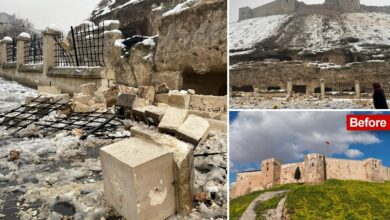World
The King Tut Tomb’s Amazing 30 Treasures

Archaeologists rediscovered Tutankhamun’s tomb in the Valley of the Kings on November 4, 1922, and it was stuffed with valuables. Some of the relics are well-known, such as his death mask. Others, albeit less well known, like a mannequin that would have assisted the young king in making clothing decisions, provide insight into King Tut’s life. Following the discovery of his remains 100 years ago, here are thirty intriguing artifacts from Tutankhamun’s tomb and what they indicate about the legendary ancient Egyptian monarch.
- Death Mask
Among the items discovered in Tutankhamun’s tomb, the death mask is arguably the most well-known. The intricate mask, which was placed on Tut’s face, is 21 inches long (53 cm), is made mostly of gold, and weighs a phenomenal 22 pounds. It is inlaid with semiprecious stones and colored glass paste (10 kilograms). - IRON DAGGERS
Two daggers, one with an iron blade and the other with a gilded one, were buried alongside Tutankhamun. Both daggers were discovered covered in various layers of the mummy bandages from the pharaoh. - BOARD GAMES
There were at least four board games in Tutankhamun’s tomb. The boards appear to be fashioned for the game of twenty and senet, and some of the game pieces discovered in the tomb were made of ivory. - GARMENT MANNEQUIN
An object from Tutankhamun’s tomb that is less well-known is a mannequin that was used to choose, customize, and store the king’s clothing and valuables. - GOLDEN SANDALS
Gold sandals were discovered on Tutankhamun’s mummy; their total length was around 29.5 cm (11.6 inches). - TUTANKHAMUN’S COFFIN
Three interlocking coffins were used to bury Tutankhamun. The total coffin weight is around 1.25 tonnes (1.3 metric tons). It was difficult for Carter to open the coffins because of their size and Tutankhamun’s tomb’s comparatively tiny size. - TUTANKHAMUN’S THRONE
Eaton-Krauss said that two thrones were discovered in Tutankhamun’s tomb. One was distinctive because it resembled a bishop’s chair and was made of ebony.
The image of Tutankhamun and his wife, Ankhesenamun, can be found on the other throne, also known as the golden throne. - CHARIOTS
Tutankhamun’s tomb had six chariots. The scientists stated in their paper that Carter referred to two of the most complex chariots as state chariots. - TRUMPETS
Two trumpets, one made of silver and the other of gilded bronze, were discovered in Tutankhamun’s tomb and are among the oldest labrosones still in existence. Labrosones are musical instruments that are played by vibrating the lips. - ANUBIS
This jackal-headed statue of Anubis, a god of mummification in ancient Egypt, was discovered in Tutankhamun’s tomb. It is constructed of gold and wood. - BREASTPLATE
This vibrant breastplate, which appears to be centered with an amulet in the shape of a scarab, was found in Tutankhamun’s tomb. Since the scarab beetle was regarded as a representation of rebirth or resurrection, these amulets were frequently discovered in ancient Egypt. - OSIRIS’S TOMB WALL PAINTING
This mural depicts the pharaoh engaging with Osiris, a god regarded as the ruler of the underworld, in Tutankhamun’s tomb. Tut went away when he was about 19 years old. - IVORY-COVERED BOX
This ivory-covered wooden box came from Tutankhamun’s tomb. The box is decorated with intricate artwork that shows motifs that are challenging to understand. - ANUBIS AND HATHOR WALL PAINTING
The ancient Egyptian gods Anubis and Hathor stand on either side of Tutankhamun in this wall mural. Anubis is a jackal-headed deity connected to mummification, whereas Hathor is connected to, among other things, fertility and love. - ANIMAL MURAL
This wall painting from Tutankhamun’s tomb purports to depict six baboons and a scarab on a boat. While scarab beetles were connected to rebirth or resurrection, baboons were brought into Egypt from further south. - CANOPIC JARS
the canopic jar lids discovered in Tutankhamun’s tomb. These containers contained the remains of internal organs that were removed during mummification, including the liver and lungs. - TUT AND WIFE
This picture was discovered in Tut’s tomb, and it depicts Tutankhamun and his wife, Ankhesenamun. Ankhesenamun’s tomb has not been located, however, it is thought to be somewhere in the Valley of the Kings. - CUP
This cup with a flower design was found in Tutankhamun’s tomb. Its hieroglyphic inscriptions make a request for millions of years of life for Tut. - JAR
The lion on top of this jar was discovered in Tutankhamun’s tomb. The symbols at the bottom might be depictions of Egypt’s adversaries in Nubia and western Asia, as well as a victory over them. It’s possible that the jar was used to store cosmetics. - SHABTI
Shabti was discovered in the tomb of Tutankhamun. Shabtis were designed to serve the departed in the afterlife and are frequently discovered in ancient Egyptian tombs. This limestone shabti is clutching a crook and a flail. - BED
This bed is one of many that were discovered in Tutankhamun’s tomb. It is made of wood that has been gold-gilded, and cows are painted on it. Cows were occasionally connected to Hathor in ancient Egypt, a goddess of love and fertility. - DIADEM
This diadem was discovered in Tutankhamun’s tomb and features images of a vulture and a snake. Along with other materials including glass, lapis lazuli, obsidian, and malachite, it is manufactured of gold. - MUMMY
The corpse of Tutankhamun still lies in state in his tomb in the Valley of the Kings. The pharaoh still resides in his tomb, despite the fact that many of the items in it have been relocated to museums. - HIPPO HUNTER
This tiny statue, discovered in Tutankhamun’s tomb, depicts the king harpooning hippos. Tut may have gone hippo hunting in real life despite his health issues. - MODEL BOAT
a boat model discovered in Tutankhamun’s tomb. The model is about 3.9 inches (10 cm) broad and 8.7 inches (22 centimeters) long and is made of painted wood with sail rigging. - OUTSIDE BOX
The quartzite box in which Tutankhamun’s three coffins were discovered is depicted here. It is inscribed with images of the four goddesses Isis, Nephthys, Neith, and Selket. - MORE SHABTIS
Added shabtis were discovered in Tutankhamun’s tomb. One of them is wearing a Nemes Headdress, while the other is wearing a Nubian Wig. - WOODEN BOX
a wooden box with paint on it that was discovered in Tutankhamun’s tomb. On it are pictures of hunting settings. - GOLD BUCKLE
This buckle made of gold was discovered in Tutankhamun’s tomb. The pharaoh is shown in it driving his chariot. - HEADREST
This blue faience (glazed ceramic) headrest was discovered in Tutankhamun’s tomb. It might function somewhat as a pillow.
News Mania Desk






